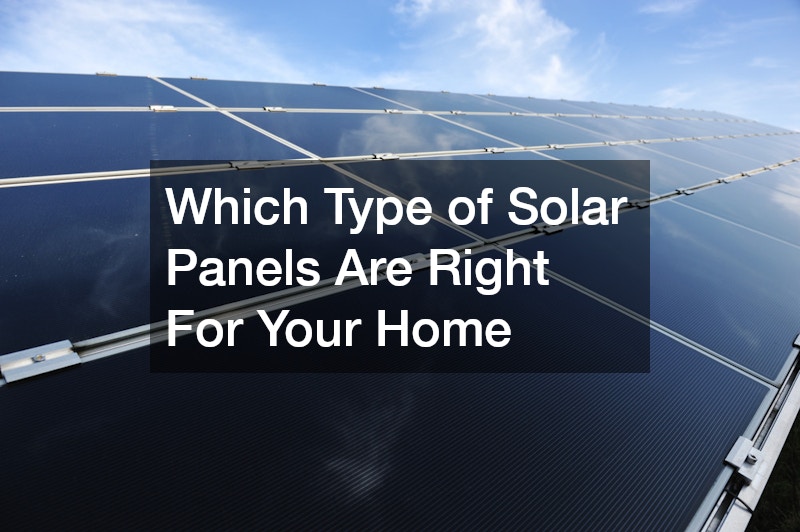Choosing the right type of solar panels for your home can seem overwhelming. With so many options available, understanding the differences and benefits of each kind is essential for making an informed decision.
Installing panels is a significant investment, so selecting the best fit for your property, budget and energy needs is crucial. This article explores the main types of panels and guides homeowners in determining which suits them best.
Understanding the Different Types of Panels
Panels generally fall into three main categories: monocrystalline, polycrystalline and thin-film. Each type has unique characteristics that affect efficiency, cost, lifespan and aesthetics. Knowing these distinctions helps identify the solar panel technology that aligns with your household’s priorities.
Monocrystalline panels are made from single-crystal silicon. They typically have a uniform black appearance and are the most efficient option, converting more sunlight into electricity compared with other types. This makes them ideal for homes with limited roof space because fewer panels are needed to generate the desired power output. Monocrystalline panels are known for their longevity and reliability, often carrying warranties of 25 years or more.
Thin-film panels differ significantly from the crystalline options. These panels are manufactured by depositing photovoltaic material onto substrates such as glass or metal. They are lighter and more flexible, allowing for innovative installation options such as on curved surfaces or integrated into building materials. Thin-film panels usually have a lower efficiency and shorter lifespan, but their lower cost and aesthetic flexibility appeal to certain homeowners and commercial applications.
Factors to Consider When Choosing Panels
Several factors influence which type of solar panels will work best for your home. Roof size and shape are critical. If your roof area is small or has shading issues, higher-efficiency monocrystalline panels may maximise energy production in limited space. For larger roofs with fewer shading concerns, polycrystalline panels can be a cost-effective option that still provides solid performance.
Your budget will also play a key role. While monocrystalline panels offer superior efficiency, they come at a premium price. Polycrystalline panels provide a middle ground, delivering reasonable efficiency at a lower upfront cost. Thin-film panels usually have the lowest initial cost but may require more space and replacement over time due to reduced lifespan.
Your home’s orientation and shading affect solar panel performance. If shading from trees or nearby buildings is unavoidable, panels with higher efficiency or technologies designed to mitigate shading impact will optimise output. Some panels include features like bypass diodes that help reduce power loss in shaded conditions.
The Importance of Quality and Warranty
Choosing reputable brands and high-quality panels is essential for long-term satisfaction. Many manufacturers provide warranties that guarantee a certain level of performance over 20 to 25 years. These warranties cover defects, degradation and efficiency drops. It is important to carefully review warranty terms when selecting panels to ensure protection for your investment.
Installation quality also affects solar panel performance and longevity. Using a licensed installer who understands the technical and regulatory requirements in Australia ensures your system is safe, efficient and compliant. Proper installation maximises energy generation and minimises potential maintenance issues.
Panels and Energy Savings
Investing in panels offers considerable benefits beyond reducing electricity bills. Solar power helps lower your home’s carbon footprint, contributing to environmental sustainability. Depending on your location, excess energy generated by your panels can be fed back into the grid, earning you credits or payments through feed-in tariff schemes.
To maximise savings, it is important to match your solar panel system size and type to your household’s energy consumption patterns. A system that produces more energy than needed may result in wasted potential, while an undersized system will not meet your needs effectively. Consulting with a solar energy expert can provide tailored recommendations based on your energy use, roof characteristics and budget.
Making the Right Choice for Your Home
Selecting the best panels for your home involves balancing efficiency, cost, aesthetics and durability. Monocrystalline panels suit those prioritising high performance in limited space and are willing to invest in a premium solution. Polycrystalline panels offer a practical, budget-friendly alternative for homes with ample roof space. Thin-film panels provide innovative options for unique installations but are less common in residential settings due to lower efficiency.
With continued advancements in solar technology, all three types of panels are improving in efficiency and affordability. This makes solar power increasingly accessible for Australian homeowners seeking to reduce energy costs and environmental impact.
If you are considering solar panels for your home, take the time to research and compare options. Seek advice from certified solar installers to ensure your system meets your needs and complies with local regulations. By choosing the right panels, you can enjoy reliable, clean energy for many years to come.
.

